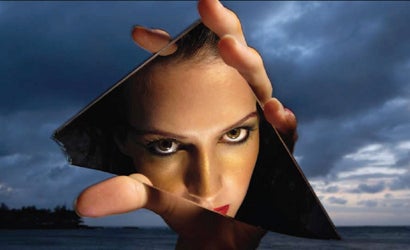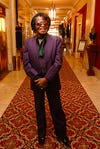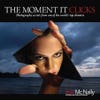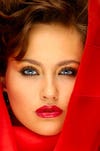All About the Moment
Magazine photographer Joe McNally opens up his vast image vaults -- and how-to notebooks -- in a new educational photo book.

In addition to his versatile body of work for such magazines as National Geographic, Sports Illustrated, The New York Times Magazine, Time, and Newsweek, photographer Joe McNally is also a sought-after educator, sharing how-to tips and telling anecdotes at workshops and lecture series throughout each calendar year. In McNally’s new book, The Moment It Clicks: Photography Secrets from One of the World’s Top Shooters (New Riders Publishing, $55), he shows off both of these aspects. One one hand, the book is a retrospective of McNally’s editorial, portrait, and commercial photography made over more than three decades. Each spread contains a single image from his portfolio, ranging from serious photojournalistic assignments to lyrical personal projects.
But much of McNally’s accompanying text reads like a how-to manual, with case studies about how particular imaging problems were solved, tips about lighting and exposure, and generous doses of McNally’s folksy, witty lecturing style. “Scott Kelby, of Photoshop fame, is the editor of the book and the real reason it is published,” confides McNally. “He took one of my lighting classes and urged me to start writing down what I was teaching, in a conversational, irreverent way, which is the way I teach. Thus the tone of the book.”
For more information about how McNally’s book was put together, check out this background clip created by Nikon. For more on his work and teaching schedule, visit his website.
Aside from technical tips, McNally’s book showcases a mastery of the medium that’s grounded in common sense. “I can’t tell you how many pictures I’ve missed, ignored, trampled, or otherwise lost just ’cause I’ve been so hell bent on getting the shot I think I want,” the photographer relates in “Shoot What You Love,” the book’s first chapter. “You always have to go into the field with an idea. Hopefully, a good idea. But a good idea becomes a bad idea when you don’t see anything else. So turn around. Look around.” What follows are a few more of McNally’s book excerpts and their accompanying photographs.
Click photos to enlarge.
Prepare to Launch
McNally says this photo was part of a magazine assignment to take a tongue-in-cheek look at the U.S. Winter Olympic Team. “I always had a good relationship with the people who run the Empire State Building, so I asked if I could put a skier at the edge of the building. Surprisingly, they said yes,” he recalls. “We’re about 100 stories up and the wind is just howling, so it’s not the time for an umbrella or a softbox. I took a strobe, positioned it to the right of the camera and put on a honeycomb spot grid so the light wouldn’t spill over everything.” “Look at the window to her left. Imagine the same photo if that window was black,” he adds. “By putting a little light into it, the window comes alive and the picture has more depth. So I put a strobe head in there covered with a blue gel (which worked well with her orange suit). Once the lighting was in place, we put her in position, waited for dusk, and shot very quickly. It wound up as a double truck in Life.”
Another Side of Tony
For a portrait of Tony Bennett for Parade magazine, McNally shot several background variations, including this deliberately dark one. “He loved the old prop microphone and he turned that wonderful, soulful face into the one light, and it was the picture of the day,” McNally recalls. “In a scene like this, you try to match the light to the mood. Tony’s very soulful, so the last thing I’m going to do is blast him with a whole bunch of brassy, hot light. I positioned a big Octabank1 to my camera’s left and slightly behind him, so it starts to wrap around that famous Bennett profile.”
Accenting Beauty with Light
This is an illustration of “The Over-Under,” as McNally calls it. “This is a lighting combo that gives you the classic ‘glamour look.’ Use two softboxes. Position them high and low. Think of an open clamshell with your subject’s face at the open edge, and your camera peering at him or her from the other side. The upper source is middling size…say 3×4′. The lower light is smaller, maybe 1×2′. The higher source is dominant in terms of size and exposure. It runs maybe a stop to a stop-and-a-half over the output of the lower box, or fill. “Move your subject into the wide end of the clamshell, as tight as they can get. Fill the frame. Photographer adds a dash of appropriately encouraging/suave/smarmy/inane patter from camera, and voila! This is a light grid for the ladies, who, if you do this right, will love you forever.”
McNally says this is an example of extending the use of waning daylight. “If you’re a photographer desperate for as much golden hour as you can get,” he explains, “one way to do that is to use water. Ever notice how the streets in the movies are always wet? Did it always just rain? Nope. But the water truck just went through. Streets glisten when they’re wet. They look cooler. You pick up f-stoppage. “When doing flash at the edge of sunset, you’re desperate to get that beautiful sky and face of your subject. Not too tough, actually. Hit him with some light, crank your strobe up at +2, underexpose the sky…. You can extend your sunset working life dramatically by putting your subject next to a body of water. The water remains almost the value of the sky exposure and stays right with you till the sky is almost gone.”
The Strange, Silent Types
“I don’t like mimes, but I’ve used them in shoots on numerous occasions just because they’re so damn odd,” McNally opines. “It gives you a free pass. You don’t have to explain how strange a picture is, ’cause, well, you’ve got a mime in there. When I shot this, in the muck of the Prospect Park Lake in Brooklyn, my assistant was a 6’3” cowboy out of Colorado named Garth. He was bewildered by the painted, wordless men. Maybe they don’t have mimes in Colorado. “He came up to me at the camera and whispered, ‘Hey Joe, if I beat the $#!& out of one of these mimes, do you think he’d say something?'” “This was an illustration for the versatility of the Nikon SB-26, which had an internal slave eye. There’s a strobe in the umbrella, one in the boat, and one to camera left. The shot was taken at dusk. The sky is really intensely blue, I shot tungsten film, and the strobes had CTO gels, so the tungsten film made the scene cool blue and the gels made the light from the flashes warm. Here’s why you need the gels: the Tungsten white balance makes the fading daylight go blue, and the strobe is a daylight source too, hence it will go blue if left ungelled. You don’t want blue on blue on blue…. Always remember that warm and cool colors vibrate next to each other. They engage the eye.”
A Touch of Warmth
“When it comes to skin tones, warm is generally better than cool,” McNally says. “People look better with a little warm glow, as if they’re sitting at a nice, candlelit table at the Four Seasons, rather than looking like an extra on The Sopranos who’s been hanging on a meat hook for a few days.” “Flash units come from the factory neutrally balanced for daylight. The output is plotted as a bell curve. At the lower end of the curve, it is burning at a warm temperature. At the top of the curve, it is fairly cool. Depending on certain factors, like strobe duration and shutter speed, your exposure will carve out a piece of this bell curve, and more than likely the cool chunk of it. Hence, your neutral strobe is gonna look blue. “There are any number of ways to fix this. Try a Cloudy white balance, which is a slightly warm version of daylight. Or put a CTO on your strobe: it’s an amber gel and it pushes daylight towards the tungsten (or warmish) end of the color scale. You can push it a little, which is natural and pleasing, or you can push it a lot and make somebody look like the Great Pumpkin. Be careful.”
The Godfather of Soul
This portrait of James Brown, made shortly before he died, almost didn’t happen. “I was doing a story on Augusta, Georgia,” McNally recalls. “Brown was Augusta’s favorite and most famous son, so this is a picture you need, right? Called his agent. Kept calling. Every day. For six days. Message after message. Sometimes we’d talk and I’d push as hard as I could. Got nowhere. Then, my phone went off, and it was the agent. ‘If you can be in downtown Augusta in 20 minutes, James will do this picture for you.’ “I was like a cartoon character,” McNally continues. “I got to the address she had given me in less than 10 minutes. That gave me 10 minutes to location scout, set up, and be ready to shoot. Thankfully, the location was a pretty ornate building lobby. I walked in and realized I had to make a stand right there. So I started moving furniture out into the street. “I threw up a medium softbox on a C-stand. Had no idea if that was the right light, but things get real simple when you have no time. Had just set the light and turned around, and there he was. Purple suit, green neck scarf. He offered a handshake. He said, ‘Hi, I’m James Brown.’ I looked back and said, ‘I know.'” “The long hallway saved my butt ’cause through the far doors is bright, bright sunlight. Backlight’s done! Drag shutter and the whole hallway’s lit. Angled the softbox over him, just barely out of frame. You can see it in the top of his ultra-cool specs. In a corporate shot, this hit in the glasses is cause for concern. With James Brown, you can get away with it.” “I shot 12 frames, and he looked at me and said, ‘Now, I thought you were a nice man, but here you go shooting all these pictures of me.’ I knew the session was over. Grabbed a 105mm lens, shot a couple tight frames, and I thanked him.”
Picturing Hope
McNally made this photo in 1995 of Kim Phuc, also known as “The Napalm Girl” because she had been pictured in 1972 by photojournalist Nick Ut as she ran down a road, naked and badly burned after a napalm attack on her Vietnamese village. “I was sent to find people who had been the subject of Pul

The-Strange-Silent-Types

A-Touch-of-Warmth

The-Godfather-of-Soul

Prepare-to-Launch

Photographer-Joe-McNally-s-new-book-The-Moment-It

Another-Side-of-Tony

Accenting-Beauty-with-Light

The-Wet-Look

Picturing-Hope
